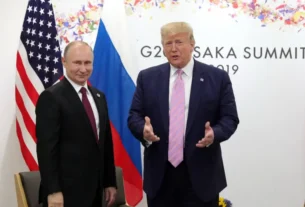As he heads into yet another volatile week of his trade wars, President Donald Trump must quickly de-escalate the conflict he started with China before it seriously harms the US economy.
After the United States imposed 145 percent tariffs on its superpower rival, setting off a long-feared direct confrontation, China’s President Xi Jinping has so far declined US pressure to call his American counterpart to seek a “deal.”
As a result, despite Trump’s repeated assurances to the American people that he has a “great relationship” with the Chinese leader that will prevent a crisis, he is unable to start talks in a standoff that runs the risk of causing stock markets to fall again and causing real hardships to the American people.
Despite the uncertainty, Trump is putting on a show of relishing multiple fights he set off, and he lapped up a standing ovation as he took a seat cage-side at a UFC mixed martial arts event in Florida on Saturday night. The president, who describes himself as the ultimate political fighter, stated to reporters that his reception proved that “we’re doing a good job” and was “somewhat legendary.” But the president’s conflict with China is a real-world showdown with far higher stakes.
Stacked shipping containers, gantry cranes, and a construction site are seen at the Yantian International Container Terminal through tree branches, with workers and machinery visible in the foreground, on April 12, 2025 in Shenzhen, China.
China has imposed a new round of retaliatory tariffs on U.S. imports, raising duties to 125% in response to the latest escalation by the United States, which increased tariffs on Chinese goods to 145%.

China’s export sector has been further impacted by the escalating trade tensions, which have had an impact on key industries like logistics, manufacturing, and cross-border e-commerce.
These measures are a part of Beijing’s larger strategy to defend its trade interests and combat rising economic pressure. Related piece Trump official says tariff exemptions on tech are temporary.
Elizabeth Warren calls trade war ‘red light, green light’ game
The impasse is so serious because the US and Chinese economies are intricately entwined. The US relies on China for consumer electronics; rare earth minerals used in the manufacture of electric vehicles and for military applications and robotics; pharmaceuticals used in lifesaving medicines; and more basic staples of daily life, including clothing and shoes.
US exports of produce like soybeans and sorghum to China are vital to the livelihoods of American farmers, but the tariffs imposed by both sides are so prohibitive that trade may effectively grind to a halt.
In the event of a full-blown trade war, both sides may suffer greatly, and US consumers may experience price increases and shortages. But some experts believe that China, owing to its authoritarian system of government, would be willing to impose more pain on its populace to avoid losing what could be a defining struggle with the US.
After bond market sell-offs began to suggest a developing financial crisis, Trump’s ability to play the long game was called into question when he abruptly suspended reciprocal tariffs on dozens of nations last week for 90 days.
That climbdown will have been carefully watched in Beijing. And in seeking to ease one sticky situation, Trump exacerbated another — lashing out at China with his 145% tariffs in an apparent effort to save face.
The White House added to the confusion Friday night by exempting imports of Chinese-made smartphones and computers from the highest tariff rate. This was an apparent acknowledgement that sky-high levies on those items could hammer the tech industry and US consumers. As the chaos gets worse, the White House added to the confusion.
However, on Sunday, the administration insisted that these products would still be subject to new tariffs, albeit at a lower level, in the coming weeks. This raised additional concerns regarding the administration’s seemingly impulsive and unplanned actions, which have frequently frightened markets. “NOBODY is getting ‘off the hook’ for the unfair Trade Balances, and Non Monetary Tariff Barriers, that other Countries have used against us, especially not China which, by far, treats us the worst!” On Truth Social, Trump wrote Sunday. “There was no Tariff ‘exception’ announced on Friday.
These products are subject to the existing 20% Fentanyl Tariffs, and they are just moving to a different Tariff ‘bucket.’ The Fake News knows this, but refuses to report it,” he went on.
The administration’s messaging causes confusion. As it has several times, the administration is insisting that its sudden moves and inconsistent messaging were part of the plan all along.
“This is just another great example of how President Trump had a detailed plan from the beginning that’s being executed exactly as directed,” White House deputy chief of staff Stephen Miller said on Fox News’ “Sunday Morning Futures.” He explained the administration’s thinking that such items are vital to US national security and thus required different treatment for “reshoring” factories that make them.
The administration maintains that its strategy is successful, claiming that numerous nations included in the suspended reciprocal tariffs have rushed to offer Trump stunning deals to evade American pressure. The White House is now applying similar logic to China, betting that the might of the US economy will force Xi to offer concessions on long-held grievances that include concerns over market access, intellectual property theft and a vast trade imbalance that Trump insists is proof Beijing is ripping off Washington.
“It’s kind of almost a two-world system. There’s a process about China, and that’s very, very nascent … and then the process for everybody else,” Kevin Hassett, director of the White House National Economic Council, told CNN’s Jake Tapper on “State of the Union” on Sunday. “So the process for everybody else is orderly, it’s clear. People are coming to town with great, great offers.”




